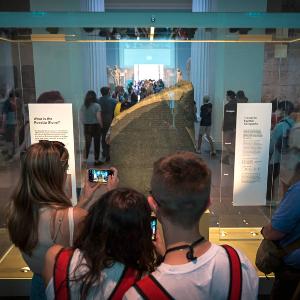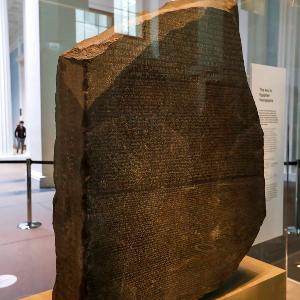How the hieroglyph puzzle was solved
27 Sept 2022
Hieroglyphic script was deciphered 200 years ago, on September 27, 1822. Egyptologist Friedhelm Hoffmann explains how this happened and why ancient Egyptian texts still have secrets to disclose.
27 Sept 2022
Hieroglyphic script was deciphered 200 years ago, on September 27, 1822. Egyptologist Friedhelm Hoffmann explains how this happened and why ancient Egyptian texts still have secrets to disclose.

The Rosetta stone in the British Museum. | © IMAGO / Eberhard Thonfeld
Professor Friedhelm Hoffmann is Director of the Institute for Egyptology and Coptic Studies at LMU. In our interview, he looks back on the great riddle posed by the discovery of the Rosetta Stone in Egypt in 1799.
The Rosetta Stone is considered one of the great archeological discoveries. Why is it so significant?
Friedhelm Hoffmann: Its discovery helped us be able to read hieroglyphs. Even for the ancient Greeks and Romans, the hieroglyphs were a great puzzle and mystery. The discovery of the stone many centuries later, in 1799, electrified people: They hoped, because the same text was written on the stone in three different scripts, that they finally had the key that would allow them to read hieroglyphs.
Why was there nobody around anymore with the ability to read hieroglyphs?
The tradition was destroyed in the process of Christianization. Christians viewed the hieroglyphs as pagan and saw the temple culture, with which Egyptian writing culture was closely associated, as idolatrous. But monuments kept the memory alive and made the Western world feel the loss all the more keenly. It had been suspected since antiquity that secrets were recorded in the hieroglyphs.
Were people hoping for precious treasure?
In the Arabic literature, yes, but classical antiquity and modern Europe weren’t all that interested in finding treasure troves. They wanted to know how the hieroglyphs worked. However, they were impeded by their own preconceptions. Baroque scholars were convinced that a hieroglyph stands for a word, a concept, or a sentence, and this held research back. In fact, hieroglyphics are a combination of phonetic and ideographic signs, but with ideograms making up only a small part of the whole.

The Rosetta stone was the first multilingual stele ever to be found. | © IMAGO / Xinhua / Han Yan
How did the Rosetta Stone contribute to this realization?
It was the first multilingual stele ever to be found. Three texts are inscribed on the stone: one in hieroglyphs, one in Demotic script, and one in Ancient Greek script. Scholars could be sure that the same thing was written in each. British scientist Thomas Young was one of the first to approach an understanding of hieroglyphs by studying their distribution pattern in the Rosetta Stone. He isolated groups of signs and came quite far with this approach. But like the others, he too believed that a hieroglyph was a symbol and stood for a concept. The principal breakthrough was achieved by Jean François Champollion, who explained before the Académie Française on September 27, 1822 that individual hieroglyphs could also refer to consonants.
How did he arrive at this insight?
Presumably, he drew on the findings of William Bankes, among others, who had managed to identify the name of Cleopatra thanks to two discoveries on one of his many trips to Egypt. In addition, representations of the names of other kings had come into Champollion’s possession; including that of Ramses, which he could read immediately, as he knew Coptic. He read the sign, which depicted a sun disk, as Ra, the sun deity. He already knew the two ‘s’ from the Rosetta Stone. And so he realized that hieroglyphs consisted of phonetic and ideographic signs. In the years that followed, he worked on a lot of different inscriptions and gradually figured out how the system works.
How many hieroglyphs are there?
In the earlier era, there were well under a thousand. The Greco-Roman period saw the addition of a few more.
Can we now read them all?
Almost everything. But new writings are constantly coming to light. In Egypt, sometimes you just have to scratch the surface to find a text. 20,000 inscribed pottery shards were discovered only recently. They include various lists compiled by administrators and schoolchildren, astronomical texts, horoscopes, and much more. The hot, dry climate and the desert sand are excellent conditions for conservation, and not only of pottery: Archeologists are continually finding rolls of papyrus, which tend to be well-preserved unless termites have got to them. The difficulty in reading them often consists primarily in the fact that many texts are damaged.
The constant discovery of texts not only supplies us with new, unknown words, but also helps us pin down the meaning of known words and grammatical rules more precisely. For this reason, every new text is a boon!Friedhelm Hoffmann
So there is much left for Egyptology to investigate?
Absolutely. Moreover, I think it’s extremely important to keep publishing new material. For Egyptologists, access to new material is what experiments are to natural scientists. The constant discovery of texts not only supplies us with new, unknown words, but also helps us pin down the meaning of known words and grammatical rules more precisely. For this reason, every new text is a boon! It would be good to compile all the new material into a comprehensive dictionary. Clearly, this is beyond the capability of a single person. And if the material increases at the same rate it has done to date, then presumably people will be grumbling again in a hundred years that we need a new dictionary!
Together with a colleague in Leipzig, you have published a four-meter-long papyrus from the 12th century B.C., which is a compendium of magic spells to ward off illnesses. Would you like to give us a sample?
Gladly. In one place, the text lists the names of spirits who were thought to help with healing. There is a particularly nice remark in the introduction, where it is recommended to write the names of the spirits on a roll of papyrus, which the patient usually hung by a string around his neck. The text has the following to say about the effectiveness of the names: “If hung around the neck of a mouse, no tomcat will catch it. If hung around the neck of a domestic cow, it will not be slaughtered. If hung around the neck of [Insert Name Here], revenants will not harm them.” This gave the scroll magic powers: it protected people from the undead and other demons.
Friedhelm Hoffmann/Stefan Pfeiffer: Der Stein von Rosetta. Reclam 2021, Ditzingen.